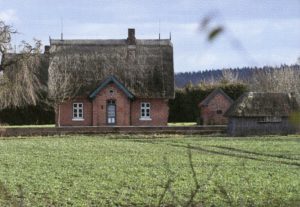Gardening in Castles and Country Houses
In the summer of 2018 Jochen Paustian published: Guts-und Schlossgärtnereien in Ostholstein. Eine historisch-geographische Untersuchung. Wachholtz Verlag, 248 pages.
Jochen Paustian wrote the book in the light of the fact that while most ornamental gardens and parks near castles and country houses are still kept in their original structure, this is not the case when it comes to the nursery, the ma rket garden and the kitchen garden of the estate. On the contrary, many of these gardens have completely disappeared, and are at present only known from maps and written sources. Now Jochen Paustian has gathered this knowledge and is passing it on to us.
rket garden and the kitchen garden of the estate. On the contrary, many of these gardens have completely disappeared, and are at present only known from maps and written sources. Now Jochen Paustian has gathered this knowledge and is passing it on to us.
The book covers gardening practices in Eastern Holstein, more specifically the area stretched out between Kieler Förde and Lübecker Bucht. Chronologically, the book sets off with the introduction of modern gardening practices (between 1650 and 1850) and ends today.
The first part of the book presents gardening at three castles: in Eutin, Plön and Panker (the first two connected to the duchy of Slesvig-Holstein, the last connected to the principality of Hessen-Kassel) and 19 country houses. The last part presents several interesting conclusions concerning different parts of gardening, based on the presentations in the first part of the book. For instance, there are chapters on subjects like: ‘From kitchen garden to glass house’, or ‘From princely or country house gardening to market garden’, ‘Gardening under National Socialism’, ‘Head gardeners’ houses’ (with pictures of the still existing ones). The book is a historical-geographical study, underlined by topographical maps and plenty of overview pictures.
In addition to this, the book includes descriptions of buildings, designs and layouts of the gardening, descriptions of the size of the cultivated area and the number of employees and their working conditions. Moreover, the book tells us about the nature of what the gardeners were cultivating in the gardens, whether it was flowers for table decoration or for embellishing graves, or vegetables for use in the princely dining rooms to impress the guests.
Furthermore, the book describes how the kitchen garden wa s often located near cow houses and stables, to avoid long transport of manure to the asparagus bed or the hotbed. Also, Jochen Paustian discusses what happened when covered glasshouses became common, and the creation of different water reservoirs was needed. In this way, the book treats almost all aspects of gardening in castles and country houses.
s often located near cow houses and stables, to avoid long transport of manure to the asparagus bed or the hotbed. Also, Jochen Paustian discusses what happened when covered glasshouses became common, and the creation of different water reservoirs was needed. In this way, the book treats almost all aspects of gardening in castles and country houses.
Among the important conclusions, the following can be accentuated: the demonstration of the spreading of new ideas from the kitchen gardens of the castles into the country houses; how market oriented structures were established and the head gardeners started selling crops from the kitchen gardens on markets conditions; how every market garden in the country side of East Holstein was started by a head gardener from a castle or a country house.
The book contains nearly all you need to know about gardening at castles and country houses and tells us convincingly about gardening and about the knowledge and skills of the head gardeners, without which the gardens of castles and country houses could not have been developed and embellished. In one of his book titles, the English garden historian Toby Musgrave calls the head gardeners “The forgotten heroes of Horticulture”. At least this is not the case in Eastern Holstein.
Bodil Møller Knudsen, Historian and Co-founder of The Danish gardening history-network and member of ENCOUNTER.